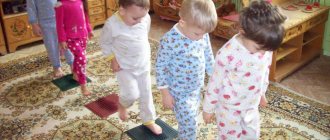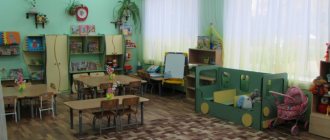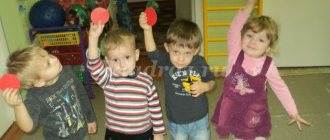Educational activities in special moments in the senior group. Card index
Tatiana Pivovarova
Educational activities in special moments in the senior group. Card index
Educational
activity in restricted moments.
Senior group.
Card index.
— Conversation “Milk”
.
To consolidate children's understanding of milk production (milking a cow, boiling, packaging in a factory)
. Talk about boiling milk as a way to keep milk fresh longer. Expand children's understanding of the environment.
— Conversation “Every thing has its place”
Teach to take care of things, remind that all things should be in their places.
Reading Art. Z. Alexandrova “What you took, put it back
. Develop a desire for order and a sense of humor.
— Conversation “Wheat”
, showing
a picture .
To consolidate children's knowledge that grain is threshed from ears of corn, from which flour is subsequently ground, and bread is baked from flour. Tell the children that the same grains can be ground in different ways - you can get flour, semolina and wheat grits. Strengthen children's knowledge about cereals. — Conversation “Valenki”
. To consolidate children's ideas about the benefits of felted shoes in winter in severe frosts. Experimentation: explain the process of producing felted shoes, clearly showing it on a piece of cotton wool. Develop interest in the world around us and the work of adults.
— Conversation “Onion”
.
Continue to consolidate knowledge about vegetables. Discuss with children that onions are eaten both fried and boiled (in soup, and raw (green onions, chopped onions)
. Recall how in the fairy tale
“Pinocchio”
Papa Carlo had only one onion from food. Bring to the conclusion that this Of course, an extremely meager breakfast, but it can support a very hungry person.
— Conversation about careful handling of clothes . Encourage people to check for gloves before and after a walk. Reading Art. G. Ladonshchikova “The mitten was lost”
. Develop KGN.
— D/i “What is the name of the soup”
.
Activate your vocabulary, develop logical thinking. Fix the names of soups: “borscht”
(beetroot and tomato soup),
“rassolnik”
(cucumber soup),
“ukha”
(fish soup),
“shchi” (cabbage soup)
.
— Conversation “How a doctor treats teeth”
To consolidate children's knowledge about the dentistry profession. Demonstrate the process of drilling a tooth and applying a filling on a large plasticine model.
— Conversation “Combing”
. Talk about the need for combing for boys too. Reading a poem about a scallop.
“Even though I quarrel with you often. Hello toothy comb! Without you, my sister can’t braid her hair. Without you, my brother would have to walk around with shaggy hair all day long.” Develop KGN.
— A conversation about brushing your teeth. Show how to brush your teeth correctly using a toothy toy as an example. An experiment with teeth cut from orange peels. Show that when moving the brush from side to side, food debris is not removed from the space between the teeth, but when moving from top to bottom, they are removed. Finger game by T. Pivovarova “Brushing our teeth”
.Develop KGN.
— Conversation “Rice”
. Remind your children about what rice dishes they know. Show on the interactive board how rice is grown, explain why it is not grown in our area. Develop children's understanding of cereals.
— Conversation “How animals wash themselves”
.
We remember how a cat, a dog, a sparrow, a duck washes itself (children tell based on observations)
. Tell how elephants and horses, bears and tigers bathe. Develop ideas about the world around you. Develop coherent speech, activate vocabulary.
— Conversation “Where does milk come from”
.
To consolidate children's knowledge about the profession of a milkmaid. Activate the dictionary with the words “milkmaid, milk, udder, calves, heifer, bull
.
Reading the poem by K. Kuklin “A Cow and a Calf Walked”
.
— "Wonderful combs"
— consolidating children’s knowledge that personal hygiene items should be individual and kept clean, instilling neatness. Reading Art. Yu. Simbirskaya “Bangs with a comb
Not afraid at all."
— Conversation “What kinds of soap are there?”
- children remember that there is liquid soap and just soap, laundry and toilet soap, with a pleasant smell. Arouse interest and positive emotions when washing hands.
- Remind children that our food is prepared by a cook in the kitchen - to reinforce the idea of professions. Reading the poem by O. Grigoriev “The cook was preparing dinner”
- develop children’s understanding of professions and sense of humor.
— Teach to exercise self-control, encourage children to pay attention to their appearance, and the desire to be neat. Expand children's understanding of the concept of “neatness”
Reading Art. E. Cherkashina “Mama Kvochka has eight sons and two daughters. Mom bought each of us two pieces of soap, so that they would be clean, neat, beautiful and neat.”
— D/i “Guess which vegetables”
.Continue to consolidate knowledge about vegetables.
Learn to independently determine which vegetables a soup or salad is made from. Reinforce the correct pronunciation of the word “beets”
using speech therapy rhyming: “the beets began to cry, they were wet to the roots. Guys, I’m not a beet, I’m a beet.”
— Conversation “Who sews our clothes?” To consolidate ideas about the profession of a tailor. Reading Art. M. Boroditskaya “Today is the old tailor’s ”
.
— Conversation about microbes. To give an idea of microbes and viruses visible only through a microscope, which, if left on unwashed hands or vegetables, can lead to illness. Reading Art. V. Bredikhina “Once a microbe settled in”
— Conversation “Autumn and winter clothes”
. Discuss similarities and differences. Riddles about winter clothes (“Two sisters, two braids made of fine sheep’s wool. How to go for a walk - how to put it on, So that five and five don’t freeze.” etc.)
-D/i “Guess which vegetables”
.Continue to consolidate knowledge about vegetables.
Learn to independently determine which vegetables a soup or salad is made from. Talk about which vegetables can be eaten raw (carrots, cabbage, cucumbers, etc., and which vegetables can only be eaten boiled or fried (beets, zucchini,
potatoes ) .
— Conversation “Fry, cook”
. Clarify children's understanding of fried and boiled foods and methods of cooking. Invite children to discuss which food, fried or boiled, is healthier. Expand children's understanding of the world around them.
— Conversation “Garlic”
. Clarify children's understanding of the benefits of this vegetable for the prevention of colds, tell children about the volatile substances contained in garlic, which determine its specific smell. Expand children's understanding of the world around them.
— Riddle conversation “How are orange and garlic similar”
Lead the children to the conclusion that garlic and orange have
“slices”
. Expand children's understanding of edible parts of plants. Develop logical thinking.
— Conversation “Ironing clothes”
as a preliminary work for the role-playing game
"Family"
.
To arouse in children a positive idea of this type of work activity , to develop respect for the work of adults, to consolidate the idea of the aggregate states of water ( “if there is intense heat somewhere, there will be steam from the water”
).
— Conversation “We are all friends with cleanliness”
, about the need to remove garbage
generated during play and activity .
Explain the meaning of the proverb “Garbage is something that is not in its place. Develop children's work skills and a positive attitude towards them. — Conversation “Let’s color our breakfast”
Show children on the interactive board
pictures-examples depicting these ideas for a fun, festive breakfast are not for every day. Offer to color breakfast like this at home, with your mother Increase children's appetite, develop ideas about cooking, maintain children's interest in the process of cooking.
- Conversation "Festive clothes"
.
Ask the children how festive clothing differs from everyday clothing. Reinforce the concept of “Clothing”
. Create a desire to take care of clothes, to be beautiful and tidy.
— Conversation “Where does milk come from”
.
To consolidate children's knowledge about the profession of a milkmaid. Activate the dictionary with the words “milkmaid, milk, udder, calves, heifer, bull
.
Reading the riddle poem by Yu. Chernykh “Who is grazing in the meadow?”
/ Develop logical thinking.
— Reading the fairy tale “Scarecrow”
. Lead children to the conclusion that an unkempt appearance is unpleasant to others, but a neat person makes them want to communicate.
— Conversation on ethics and culture of behavior on the topic “Bread”
. To update children’s ideas about the work of grain growers, to cultivate respect for bread.
— Experimenting “Huge Soap Bubbles”
Show children how to use a soap solution and a loop to blow an unusually large soap bubble. Arouse interest in soap and soap foam, a positive attitude towards washing.
— Conversation “Why you need to put toys away”
Re-enactment with a boy doll
“Petya didn’t like cleaning”
- invite the children to continue the story started by the teacher, lead them to the idea that they can trip over scattered toys.
Teach children to put toys in order, put them in place; encourage the desire to establish and maintain order, explain how order and safety in the group .
— “Why is the shoe “asking for porridge”
— explain to children the meaning of the saying, induce a desire
to handle shoes with .
- “I'm straight as an arrow”
.
Practical exercise during afternoon tea “Correct body position while eating”
with all children. To reinforce children’s ideas about the need to develop correct posture.
— Conversation “Sugar”. Tell the children that sugar is made from beets. Remind us of the property of sugar to dissolve in water. Experimenting - where will sugar melt faster, in cold or hot water? Expand children's knowledge about the world around them.
— Conversation “Sweets”
.
Invite children to list their favorite sweets, tell them that sweets are made with sugar or honey. Talk about the benefits of a small amount of sweets (they help you think, give you strength, and the dangers of consuming a large amount of sweets (teeth spoil, a person gets fat, can get sick)
. Expand children’s knowledge about the world around them.
— Conversation “Brushes”
.
“A toothbrush – why is it needed?”
D/i
“What types of brushes are there
?
Reading the rhyme “Brushes”
: “I brush my teeth with this brush, my shoes with this brush, I clean my trousers with this brush,
These brushes are all needed." Develop ideas about the world around you, about the need to brush your teeth (and clothes)
.
— Conversation “About tasty and healthy food”
.Give an idea of healthy foods: vegetables, cereals, milk, eggs, fish and meat.
Tell us that we need nutrition to grow and maintain strength. d/i “Find harmful products”
(from Spanish
cards with images of vegetables , cakes, milk, sweets, lemonade, chips, etc.)
- Conversation about fruits. Continue to consolidate knowledge about fruits. Learn to independently determine from which fruits and berries compote and jelly are made.
— Conversation “Vitamins”
. Talk about the benefits of vitamins and their importance for human health. Encourage children to understand that proper nutrition is necessary for good health. Tell children about vitamins, the functioning of which organs they help and what foods they contain.
— Conversation “Do you have a napkin?”
To form the necessary ideas about the rules of behavior at the table. Learn to use napkins as a necessary serving attribute.
— —“Pills grow on a branch, pills grow in a garden bed”
Strengthen children's knowledge about vegetables and fruits.
To form the concept of “proper nutrition”
, an idea of how nutrition helps to avoid many diseases.
— Conversation “Threads and needles”
. To consolidate ideas about the profession of a tailor and the attributes of his profession. Create a desire to be neat and take care of clothes.
— Conversation “Polite words at the table”
.
Continue to introduce children to the rules of table etiquette. Guessing the riddles of O. Emelyanova “Polite words”
.
— Conversation “Why do you need a comb?”
Experimentation: show children a tangled skein of thread, offer to untangle it. Explain that hair also gets tangled if you don’t comb it. Reading a poem about V. Kuzminov’s comb “There’s a whole row of sharp teeth, But they don’t eat with them!” What runs like a filly From the temples to the back of the head?
— Conversation “Allergy”
tell children about allergies, what is the basis for the fact that some children cannot eat certain foods. Invite children to also take care of their comrades, make sure that they do not mistakenly eat the foods in which they have been limited.
— Conversation “Lapti”
.
Expand children's understanding of shoes. Tell the children that in the villages they used to walk around in bast shoes woven from linden bark (display on the interactive board, or just barefoot, and boots and boots could only be bought by very rich people. Explain the meaning of the proverb “ Don’t dare to weave bast shoes without hurting your bast.”
Continue introduce children to folklore, Russian folk traditions and customs.
— Conversation “Wheat”
. Expand children's knowledge about the environment. Give children the knowledge that from one wheat grain, depending on the grinding, you can get flour, semolina and wheat grits.
— Conversation “Semolina and wheat porridge”
. To consolidate children's knowledge that semolina and wheat grains are made from wheat grains, ask them to think about whether it is possible to make wheat grains from semolina? What about the other way around?
— Conversation “Divide the bread in half, even though you are hungry.” Invite children to explain the meaning of the proverb, to explain agreement (or disagreement)
with her. Form in children the habit of sharing with friends. Maintain a careful attitude towards bread.
— Conversation “Soap is the friend of our hands.” Reading the fairy tale by O. Shikhzamanova “Pumpatus and Soap Bubbles”
. Encourage children to have a positive attitude towards washing.
— Conversation about hospitality. Explain to the children the meaning of the proverb “What’s in the oven is on the table.”
To develop children's ideas about folklore and Russian folk traditions.
— Conversation “Dough”
. Talk about the dough as the basis of any baking, explain that the most important component of the dough is flour. Experimentation: making dough from flour, water and salt together with the children. Continue to expand children's understanding of the world around them.
— Conversation “Salt”
.
Talk about the importance of salt, that salt is added to almost every dish. Explain how salt is extracted (evaporation from sea water or extraction of rock salt in quarries)
.
Expand children's understanding of the environment. Explain to children the meaning of the traditional Russian wish “Bread and salt!”
. Continue to introduce children to folklore, Russian folk traditions and customs.
— Conversation “ Potatoes are the second bread ”
Discuss the saying.
potato dishes they know .
Expand your understanding of the environment. D/i “Guess which vegetables”
.Continue to consolidate knowledge about vegetables.
Learn to independently determine which vegetables a soup or salad is made from. Remember whether they grew underground ( potatoes , carrots, or above the ground (cucumber, tomato)
. Expand your understanding of your surroundings.
— Conversation “Dairy products”
Invite children to list what dairy products they know, tell which products are made from raw milk (kefir, curdled milk, cream, and which ones are made from heated, boiled milk (
cheese, cottage cheese)
. Activate the vocabulary, expand children’s ideas about the environment.
— A conversation about proper ear care. Goal: to help improve healthy lifestyle skills. Reading Art. E. Moshkovskaya “Doctor, doctor, what should we do, should we wash our ears or not?”
— Conversation “Boiled milk”
Explain why milk is boiled
(for longer storage)
.
Tell us what happens if you leave unboiled milk on the table (it will turn sour)
.
Tell that when milk sours, sour cream forms , and the rest can also be boiled, and you get cottage cheese.
Expand children's understanding of the environment. — Conversation “You need to put things away - you don’t have to look for them”
.
Continue to introduce children to the rules of caring for things and the need to save their time. Reading the story “Masha the Confused”
. Activate the vocabulary with words that convey a caring attitude towards time and things
“thrifty”
,
“neat”
.
"
collected " .
— Conversation “Wash your hands and fruits so that there is no trouble”
.
Discuss the dangers of eating unwashed vegetables. Reading Art. V. Marakhina
. ” Develop ideas about the environment and KGN
— Conversation “Why do we need vitamins?”
.
To develop children’s ideas about healthy and harmful foods, about vitamins as substances necessary for humans. Reading Art. S. Loseva “Who are vitamins”
- Conversation “Wash your hands thoroughly” Explain the meaning of the word “carefully”
.
Reading Art. L. Skorneva “The mouse washed its paws badly”
Develop KGN, activate children’s vocabulary.
— “We wash doll bed linen”
.
Expand the range of work activities performed by children with a high degree of independence. Cultivate a responsible attitude towards the work received. Encourage children to make their own decisions – where to dry their laundry? (on battery)
. Remember that when water heats up it turns into steam. Develop logical thinking.
— Conversation “What fruits (vegetables)
grow in our country? To consolidate children's understanding of vegetables and fruits and their places of growth. Maintain an interest in the surrounding world, in living nature, and reinforce the idea of healthy products.
— Conversation “How sloppy - all the clothes are stained!”
Form in children the habit of taking care of their appearance.




